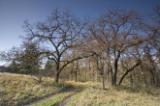The South Puget Sound Prairies
Land of Plenty by Chris Reiter
When homesteaders from the Midwest first arrived in the South Puget Sound lowlands in the 1840s, they saw a vast, wide-open prairie that may well have reminded them of home. Here, in the rugged Washington wilderness was a rolling landscape of knee-high grasses and wildflowers and spacious groves of gnarled oaks. There were deer and elk, hawks and larks, and if the settlers had arrived in the spring, a profusion of berries and flowering plants.
In May, in particular, there were magnificent blooms of wildflowers, especially the abundant Blue Camas, which was a major food source for the Upper Chehalis and Cowlitz people, who lived on the prairies south of Puget Sound. Following the Camas bloom came Golden Paintbrush and Western Buttercup, and later in the spring, enormous crops of strawberries, blackberries, and raspberries. There were thimble berries on the prairie edge and salmon berries on the creeks that flowed to the Chehalis River, where, in the fall, men fished for salmon.
Linda Storm, an ethnobotanist who studies the long relationship between plants and people on the South Sound prairies, describes the Upper Chehalis territory as “a land of plenty.” She notes the testimony of Mary Heck, a 92-year old Upper Chehalis elder, who recalled in 1927 how the prairies had “abounded with all kinds of roots they used for food…and medicinal purposes.” There were so many strawberries, she said, “you could smell it from a distance.” They ate wild rhubarb, carrots, spinach, crabapples, blueberries, wild currants, and three kinds of camas. And then there were those salmon, swimming upriver, one on top of another.
When Dale Rutledge, a South Sound farmer, was growing up on the prairie in the 1920s the salmon were still running strong. “My older brother and my younger sister and I used to walk through the woods and spend a lot of time down by the river,” he recalls. “We would swim in the summer, and in the fall, watch the many, many salmon coming upstream.” In the spring he enjoyed “the way the wildflowers looked carpeting the prairie.” He has always “had a sentiment for the land.”
Dale’s family came to the Washington Territory from Indiana in 1851. After “selling everything” his grandfather and his father “went up to Council Bluffs, Iowa, for the trip across the plains. It took them that winter and the early spring to get ready…and then they traveled five months to get here from Council Bluffs.”
The Rutledge’s settled near Littlerock, Washington, south of Olympia, and homesteaded on 160 acres of prairie and fertile bottomland along the Black River. Dale was born in the house his grandfather built and, at 87, still lives there today. As a child, he worked the farm with his father, milking cows, harvesting hay, and thrashing grain. “We raised just about everything,” he said. And even during the Depression, when his mother made his shirts from dyed muslin feed sacks, he “never went hungry.”
“My mother canned anything she could get her hands on….And of course we had our own eggs, and our own milk and beef. So we had a good living. We didn’t have any money, but eating is the better part of living anyway.”





